How to begin writing about the 2.5 weeks I spent on the island of Chios, Greece? I should use words like “volunteering” and “refugees” but it doesn’t seem right to sum it up like that. It didn’t feel like volunteering, I was living in community with these people, helping out where I could. And while “refugees” is technically the right word, it feels too distant, as these people are my brothers and sisters. My eyes are open in a new way. I know things now that I can’t unknow. And it will affect the direction of my life from here on out.
Add in the fact that things now feel totally different in my home country post-election, and I’m even more grateful I got this perspective from my time in Greece.

I’ll sum up my overall experience in this one big post, primarily told through photos but also including my attempt to synthesize the complicated politics at play in this part of the world.
Chios (pronounced with a hard “K”) just happens to be located in a strategic geographic spot — it’s part of Greece (and therefore the European Union), but it’s very close to Turkey (gateway to the Middle East). Here is a map for scale; the red drop marks Chios:

And a closer look:

Here’s a photo I took from the airplane just before it touched down in Chios — as you can see, Turkey is within sight from the eastern coast of Chios. A ferry from Izmir to Chios might only take 30 minutes. In fact, I traveled through Izmir in 2013 en route to the ancient ruins at Ephesus in Turkey — a beautiful part of the world.

Due to its location between Europe and Turkey, Chios has been an important stepping stone for many refugee movements over the past few centuries. At present, it is home to around 3,000 refugees (the numbers vary) from all over — Syria, Afghanistan, Iraq, Iran, Pakistan, Palestine, Lebanon, Somalia, Eritrea, the Congo, Libya, Morocco, Albania. Perhaps half of them are from Syria. Most have fled their home countries due to violence, bombs, and threats to their personal safety — these types of refugees are seeking political asylum in the E.U. But some are migrant workers not seeking political asylum, just a better life than their home country can offer. So everyone is grouped together and labeled ‘refugees’ but it’s important to know that most are in Greece because they had to make a life-or-death decision to flee their home countries. Here are a few of the specific stories I encountered:
- A former teacher in Syria told us how he was arbitrarily arrested one day, and taken into custody for months. At one point he was blindfolded for two weeks straight. He showed us the scars from where his wrists were bound. When he was inexplicably released, he knew he had to flee. Spent a few months trying to get work in Lebanon, but his employer did not pay him, and as a refugee he could not legally demand the money he was owed. He decided to move westward towards Europe.
- One man from Syria told us how his wife and four children were killed in an explosion. Following the tragedy he escaped their country, but now he feels like a dog on Chios — “eat, sleep, and repeat over and over with no meaning.”
- One man from Iraq showed me a photo of his wife and teenage daughter in Germany. He had only arrived on Chios a few days before, with the intention of going onward to meet his family. “Do you know when I will be able to leave to see them?” he asked me after English class one day. It breaks my heart to know that his life will be in limbo for some time.
- One young 20-something was studying I.T. (information technology) in Syria before he had to abandon his education and flee. He asked if he could join our volunteer group because he just wants to do something — everyone in camp is restless and just wants to work again, to go back to living normal lives, to have jobs and spend time with their families. Isn’t that what all of us want?
- A couple from Syria is pregnant with their third child; they already have two young daughters. It is likely that this pregnancy will help speed up their asylum hearing in Athens. They are currently sharing a prefab tent with a total of nine people.
- A young guy explained how he had to flee Syria after getting into a fist fight with someone he didn’t know who turned out to have a connection with a cousin of Assad (president of Syria). His parents and some of his siblings are still back home, but he had no choice but to get out of there or likely be killed.
- One woman was a lawyer in Tehran, Iran up until two weeks prior, when she had to flee her country. Can you imagine how many glass ceilings she had to break in her career? She speaks several languages and is no doubt much smarter than I am. Now she is currently homeless in Greece.
- One Syrian man had a connection to Connecticut, the state where I grew up — his cousin is a doctor at a hospital near my hometown. I looked him up on-line and, sure enough, he was educated at the University of Aleppo. Now the residents of Connecticut are benefiting from his medical expertise.
Everyone I met had full lives, careers, homes, and family back in their home country. In the case of Syria, their citizens have historically enjoyed free healthcare and university education. They did not want to leave, and in many cases delayed it as long as they could.
You will see the faces of most of these people throughout this post. Remember that they are no different than you and me, except they happened to be born in a country that became politically unstable during their lifetime, and they had no choice but to flee. If a similar situation happened in our own country, wouldn’t we hope the rest of the world would step up to help us? This is what we owe our fellow human beings.
Now back to the escape route to Europe:
Most refugees coming from the Middle East have to travel across Turkey (a wide expanse) to reach the coast, at which point the quickest way into Europe is to pay a smuggler to reach one of the Greek islands like Lesbos, Samos, and Chios. These islands are typically the first stop for refugees setting foot in Europe, though camps in mainland Greece are also at capacity. In total there are around 57,000 refugees in Greece (as of June 2016). As you might recall from news headlines over the last 18 months, Greece is going through a debt crisis and isn’t in a great position to absorb that many people. The E.U. has thrown money at Greece to contain the refugee crisis before it spreads deeper into the continent, but that is far from an effective resolution to the problem. Greece processes refugees at a very slow rate, leaving the vast majority living in limbo for likely years. Historically, “once displaced for six months, a refugee is likely to remain displaced for at least three years, with the average length of displacement now estimated at 17 years” (via). Most of the refugees I met were hoping to reach Germany as their final destination, as that country has the best reputation for moving refugees through the system at a reasonable speed — transitioning them to an apartment, making them eligible for employment, and ultimately gaining citizenship (way down the road). But a major roadblock was set in place earlier this year — a deal between the E.U. and Turkey which closed the borders to refugees arriving after March 20th, 2016. You can read more about it at that link, but the bottom line is that this deal closes the path from the Greek Islands to mainland Europe for refugees; they will be sent back to the first country they are fingerprinted in. Prior to March 20th, it was possible to land in the Greek islands, be in Athens a few days later, and then in Germany a few days after that. But now people are stuck. This means that families have been split — I met many refugees on Chios with spouses, children, or siblings who had gone ahead to Germany, and now they are stuck in Greece without a clear way to reach them. I also met people who had left their families in Syria while they forged ahead into Europe, with the hope that they will set up a life for their spouses and children to join them. But that March 20th agreement is making things much more difficult. One other thing I should mention connected to that deal: Turkey very much wants to secure visa-free travel for its citizens within the E.U. If the E.U. denies this, Turkey has threatened to stop taking back refugees from Greece. Supposedly the E.U. will formally respond to that part of the deal soon — this is an actively shifting situation. While refugee arrivals slowed down on Chios during October, people are concerned that once the E.U. denies Turkey’s request, the floodgates will open and way more boats will land on Greece’s shores.
There are so many more politics at play. I do not fully grasp them all, but those are the main ones I learned about.
I volunteered with a local group called CESRT, which stands for Chios Eastern Shore Response Team. The group has roughly 30 volunteers, but its faces change almost every day — someone is always leaving, and someone new is always arriving. Continuity is held by the three main leaders who are the most selfless people I’ve ever met — a local Greek woman named Toula, and a Scottish couple named Andy & Frances. Then there are around seven coordinators who are on the island long-term volunteering for the group; they each serve a different role in leading certain areas for the team (e.g. English lessons, the Women’s Centre, working with the ‘unaccompanied minors’ school on the island, etc.). And then the rest of the group are volunteers who come for anywhere from three days to three months. Here is a group photo taken one day during my time on Chios:

While there are many big NGOs on the island (UNHCR, Save the Children, Samaritan’s Purse, Drop in the Ocean, etc.) our team is much smaller. CESRT’s goal is to fill in the gaps without overlapping the NGOs — so we focus on meeting the boats of refugees as they arrive, distributing donated clothing throughout the main camp, and providing English lessons in the park, among other things.
Meeting the boats is especially important work — they can arrive at any time of the day (but more commonly at night), chock-full of people fleeing their homeland with little more than the clothes on their back. Smugglers have crowded them into an inflatable raft and pushed them off the shore towards Greece with little more than a “Good luck!” Reports vary, but it costs roughly around 1000 euros per person to make this trip. During my 2.5 weeks on the island, one refugee swam across because he could not afford the smugglers’ fee.
As for the actual crossing, many rafts attempt it, but not all get through on the first (or even second or third) try. There is an invisible line marking the border between Greece and Turkey — if the Turkish Coast Guard catches them before they reach the midway point, they force them back to Turkey. If they get past the midway point then they SHOULD be allowed to continue onward to the Greek coast, but there have been cases of the Hellenic (Greek) Coast Guard towing them back into Turkish waters. A group called Frontex also has a presence in these waters — from their website, Frontex “promotes, coordinates and develops European border management in line with the E.U. fundamental rights charter and the concept of Integrated Border Management.” In addition, a group from Spain called SMH (Salvamento Maritimo Humanitario) had rescue services on water and land (pictured below mid-rescue). However, the week after I came back home, they were told by the local municipality that their services were no longer needed(!). They did incredible work, saving lives on a routine basis, and were great partners for our group to work with. They might return to the island in the future but in the mean time Chios is worse off without them.

So as you can see, crossing this 4.3 mile stretch of water from Turkey to Greece in an inflatable raft is dangerous, costly, and high-stakes.
It is not necessary for all volunteers to rent cars, but for those who do, they carry ‘car stock’ — enough supplies and dry clothing to greet a newly arrived raft of refugees. Car stock has a carefully gathered batch of clothes for all sizes and ages. Plus water and food packs. You can always tell which cars belong to the CESRT volunteers because they look like this:

Since I never learned how to drive stick shift (big regret — it’s on my bucket list), and there are only three automatic cars for rent on the whole island, I did not rent a car. (FYI: standard cars can be rented for as little as 10-12 euros per day, and automatic cars for 20 euros per day.) Volunteers are very generous about offering rides to those of us without cars. If you are not renting a vehicle, CESRT requests that volunteers contribute 30 euros per week to be split among the drivers to help cover the cost of rental and petrol. There is also a local bus system that I used a handful of times when no one was immediately available to give me a lift. It worked out fine. If I was there with another person it would have been worth it to rent a car and split the cost, especially because volunteers with a car are in a better position to help CESRT (like being able to do Night Shift — more on that in a bit). But as a single person I was glad to share rides with others.
While the refugee crisis is in full bloom on Chios, it sort of blows my mind that this is still a Greek island, with all the beauty one would expect from such a place. The water is beautiful. There are large houses all over. It’s a vacation destination.

Let’s dig more into what being a volunteer for CESRT is like, as that is how I spent my time on the island.
Every morning at 9am, there is a group meeting at the main warehouse. We talk about any news from the past 24 hours that effects the refugees, and then sign up for that day’s activities and tasks. This meeting usually takes 45 minutes.

Here is the assignment board:

Generally speaking, there are things that need to be done in the morning and afternoon, so most days you sign up for two things. I spent most mornings sorting clothes or diapers in the warehouse, and then the afternoons teaching English in the park. But it varied day-to-day, so over the next few photos you’ll see the other things I got to do.
Here is our impressive warehouse, full of stock for the refugees — almost all of those boxes are clothing donations, sorted by season, size, gender, and age (baby, kid, teen, adult). The container in the center is where we sort the most recent donations — so for example there are bins for women’s jumpers (aka sweaters) sizes S, M, and L… men’s trousers in S, M, and L… long sleeve shirts, t-shirts, teen clothes, and a whole baby section. This is where we grab items quickly to refill car stock or pull clothes for newly arrived refugees.

One morning myself and four other volunteers spent 2+ hours counting and sorting baby diapers, then arranging them into a shipping container.

It’s important to get an accurate count of supplies so that the team leaders know when to restock.
We spent another morning counting shoe size donations — while weeding out only shoes that are appropriate for winter weather in Greece, and putting summer shoes aside until the weather warms up in a few months.

CESRT rents a second warehouse by the sea in the village of Karfas — it’s just a lovely spot.
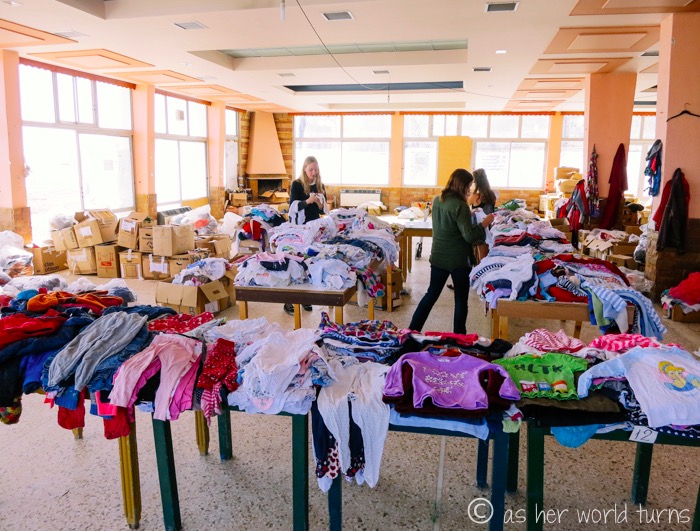
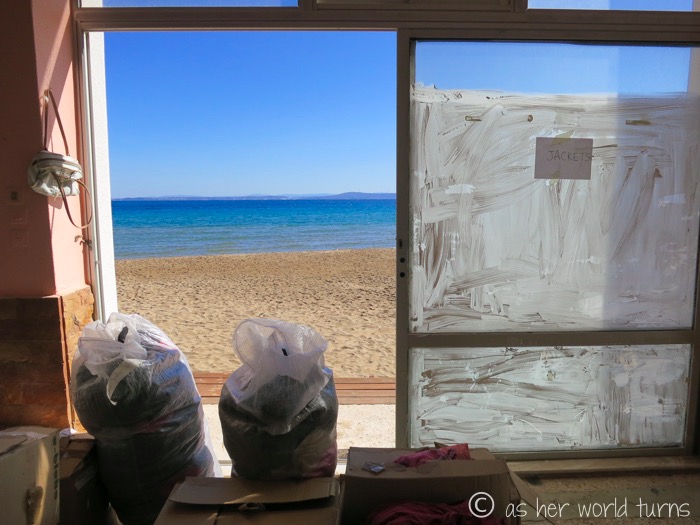
Here we are sorting baby clothes by age and type… we did this for three or four days straight, until I could look at a onesie and tell you if it was size 6 months or 9 months. But the monotony was really rewarding — after we spent each morning sorting the clothes, a new team of people would spend the afternoon bagging one of each item (leggings, pants, short onesie, long onesie, jacket, baby trousers) into a package that would be delivered to each family with little children in camp the next day. A few days later, I saw kids walking and crawling around in clothes I recognized from our sorting efforts!

We would often break for lunch at a local cafe or coffee shop. This also allowed for socialization with other volunteers — everyone was really terrific and I enjoyed getting to know them.
In the afternoon, I’d catch a ride into Chios — yes, the main port city is also called Chios, just like the name of the whole island — it’s really pretty and there are tons of cafes and coffee shops where you can sit and watch giant yachts arrive. Totally incongruous with the refugee camp located five minutes away on foot.

CESRT has had a hut located in the port (update at the bottom of this post) — that is because most new arrivals start here, before they are taken to be documented and fingerprinted. So we keep it full of warm blankets, water, clothes, and supplies. That way if we greet new arrivals at the port, we don’t have to use our car stock; everything is already stocked up in the hut. There is a second structure right next to the hut where new arrivals can sit for awhile before they have to get on the boat to be processed (this all depends on the time of day and how generous the local authorities are feeling).

A look inside the hut:

I can’t believe it’s taken me until this long in the post to talk about the specific camps! Here is a brief explanation:
At present, there are two refugee camps on Chios island. One is located in the port city of Chios — that camp is called Souda, and there are about 1,300 refugees there. The other is located much further inland and is run by the Greek military since it used to be a former detention center — that one is called Vial, and there might be around 1,500+ refugees there (I didn’t get an exact figure). I’ve heard there are roughly 3,000 total refugees on the island but take that with a grain of salt since it’s a constantly shifting figure. A few months ago, there were more camps near the port, but the local municipality dissolved them; those refugees either went to Souda, Vial, or hotels. If there are vulnerable cases — such as a women who’ve just given birth, or in some cases families — they might be moved to hotels temporarily or long-term. I also heard about two transgender cases who were granted space in hotels.
CESRT mainly provides support to the refugees at Souda. While the team would like to support Vial too, we are not allowed inside since it is run by the military (and, from what I hear, not a great place to live). Occasionally they will allow our group to do a clothing distribution at Vial, but it must happen outside the camp.
So everything I will describe next is about Souda.
Here is a photo overlooking Souda — as you can see, it’s located just inside the city walls; the sea is on the other side:


Souda is a combination of tents, prefab huts, and giant rubb halls which have partitions for each family.
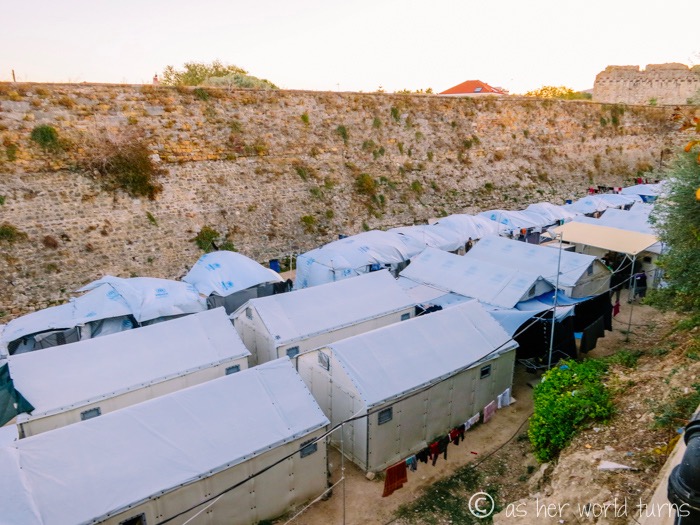

While most of the tents are behind the wall, several are located right on the sea. The wind got quite bad during my time on the island — I can’t imagine how they slept at night with the tents constantly flapping. As you might imagine, refugees from various countries tent to group together, and it’s mostly men from North Africa in those exposed tents right on the water.



These are the prefab tent structures:
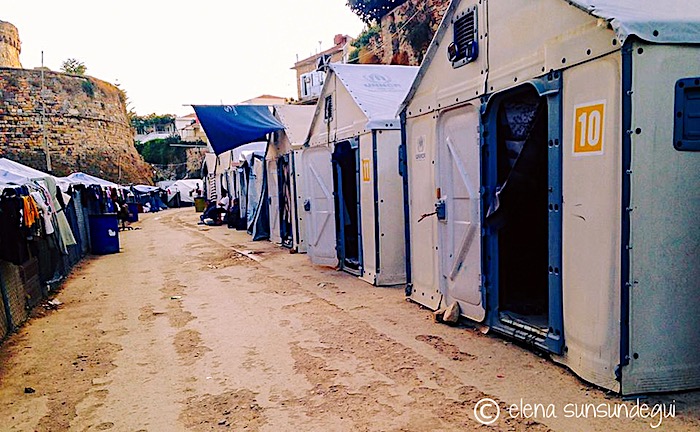
I took very few photos walking around Souda, so you’ll notice that I’ve credited other sources in a few instances — I pulled these from the CESRT Facebook page. I wouldn’t want to make Souda’s inhabitants feel any more scrutiny from someone like me taking out a camera. Refugees already have their rights infringed upon on a regular basis, and I didn’t want to add to that.
A quick word about the dynamics of the camp — despite the fact that there are refugees representing many different nationalities, some of whom are in active conflict with each other back in their home countries, the camp is peaceful most of the time. There are some exceptions: a handful of Albanian citizens have been known to loiter around charging stations to steal cell phones, which is a literal lifeline for many of these refugees to reach their families back home. There are only a few bad apples in the whole camp, but they have created lots of stress for everyone living there.
Most recently — in just the last week — the camp has also come under attack by a group of local Greek fascists who do not want refugees living on their island. They have started fires and dropped boulders onto tents from above. Now the residents of Souda are under threat in a new, terrifying way. I’ll write more about this at the end of this post.
Here are the rules of Souda, posted for its residents (click through for a high res pic that is easier to read):
 And this paperwork explains details related to refugees’ asylum interviews; as you can see, it’s not an uncomplicated process:
And this paperwork explains details related to refugees’ asylum interviews; as you can see, it’s not an uncomplicated process:

The best part of visiting Souda was being invited into tents for tea and conversation. I loved getting to know people this way. It brought some normalcy to a very not-normal situation — to simply sit and talk over a cup of tea.
One of my friends, Loay, was the most generous host — he invited groups of volunteers over to his area on a regular basis to share not only tea, but full meals. Here we are the first time I attended one of his lunch gatherings:

And another lunch the following week — with fresh tabbouleh, a sweet cole slaw, french fries, and chicken.

Another afternoon we chatted with these families for a few hours. It was my first time talking to women in Souda since until then most of my interaction had been with men at English class.


Speaking of English class… 3-5pm was the best part of my day. We sat on tarps in the park and got to know each other while talking about vocabulary and verb conjugation.

There were usually around 35 people — maybe 8 volunteers, and 25 students. During my time there, Frank and Eileen (from Ireland) took the lead on English classes and set the most welcoming tone. CESRT assisted with resources — laminated sheets for each lesson, photocopies that students could take home and practice, and notebooks with pens for students to take notes. Frank & Eileen helped to coordinate all this. My friend Carrie from the States had sent a Farsi-English book (to go along with an Arabic-English book they already had) which was so helpful. Each day we talked about a different topic — like learning months and days of week (especially how to say birthdays), or family relations (sister, uncle, grandmother, cousin, etc.), parts of the body (especially as they related to pain — so they could communicate that to a doctor), clothes, food, geography, and so much more.
It is mostly men who attend, since there are centers for women and children, but the men sort of fall through the cracks in regards to programming.

Often people with more English language experience would split off to learn about harder things, like idioms (side note: until now I’d never stopped to think about how many idioms involve chickens). We’d often end by playing a few rounds of Hangman, which it suddenly occurred to me is actually a super violent name / image for a vocabulary game. But the students loved playing it.

One day after class, Frank & Eileen brought some musical instruments and people played or sang songs from their home countries. Another day we had an impromptu dance party after class. There is a lot of joy in this group.
Sometimes after class we’d take selfies. These are wonderful people, and they are the photos I find myself looking through often because they bring back such happy memories. I miss their faces and personalities so much!



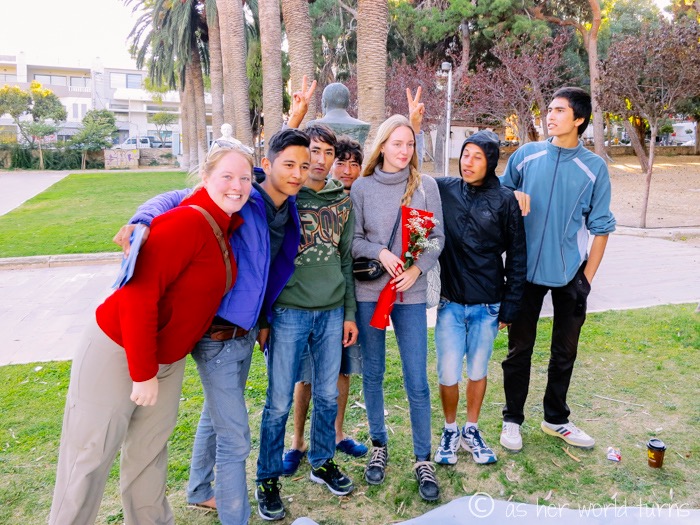


I tried to learn some basic Arabic while I was there — my cheat sheet is below. It was fun to switch roles with the students as they watched me struggle to say these vocab words:

After spending the past several months holding English classes outdoors in the park, CESRT needed to find an indoor space for the winter. And they did! These photos were taken about two weeks ago at the new indoor space:

Moving on… a few more of CESRT’s responsibilities include:
Night Shift — this is when volunteers drive a stocked car to patrol the beaches from 3-8am, looking out for refugee boats. Since I didn’t rent a car, that limited me signing up for Night Shift. But I got to do it one night with Frances, one of the long-term leaders of CESRT — she is so gracious and knowledgeable, and I was grateful to get to know her better.


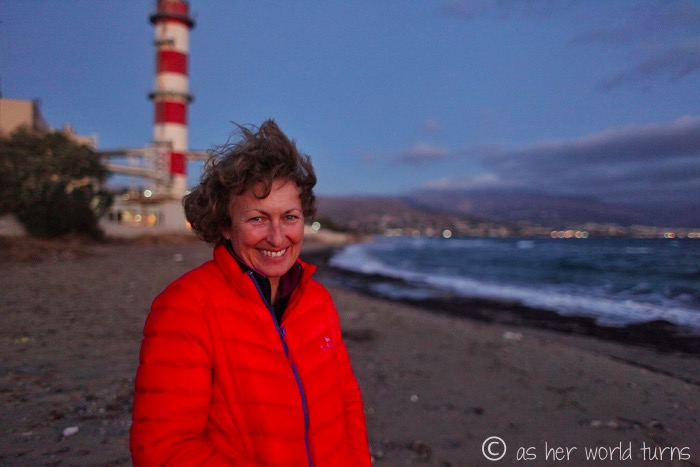
I also did Watch Tower duty from 6:30-8am, with Jasmin and Olivia from Denmark — this involved going up to a viewpoint around dawn to look for rafts with binoculars. We were in touch with the on-duty coordinator and Night Shift car in case we saw any. We’d also watch the Hellenic and Turkish Coast Guard boats (identifiable by their lights) in case they made a beeline to any particular area, as that might tip off a raft location.

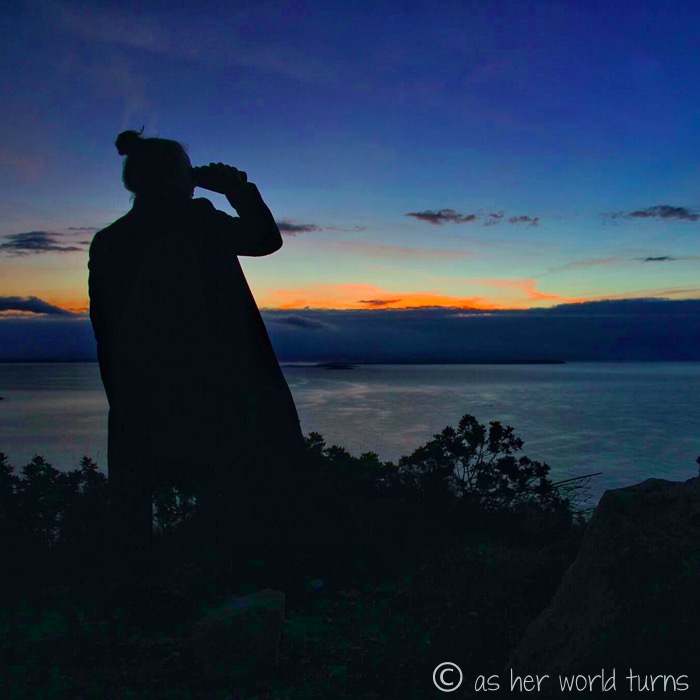
A few times our group offered children’s activities in the afternoon, but honestly, it wasn’t structured enough for a group of kids who have been through lots of trauma. Members of our team tried very hard to put activities together, but it often got out of control quickly. These kids really deserve trained professionals who can step in and give them what they need. I felt in over my head whenever I was around the kids. After a particularly chaotic afternoon, the team decided that going forward we’d park in a different location because the kids would hang onto the cars when we tried to leave.
But during this game of duck-duck-goose they appear quite angelic!

They love painting nails, and volunteer Ciaran (from Ireland) willingly submits:
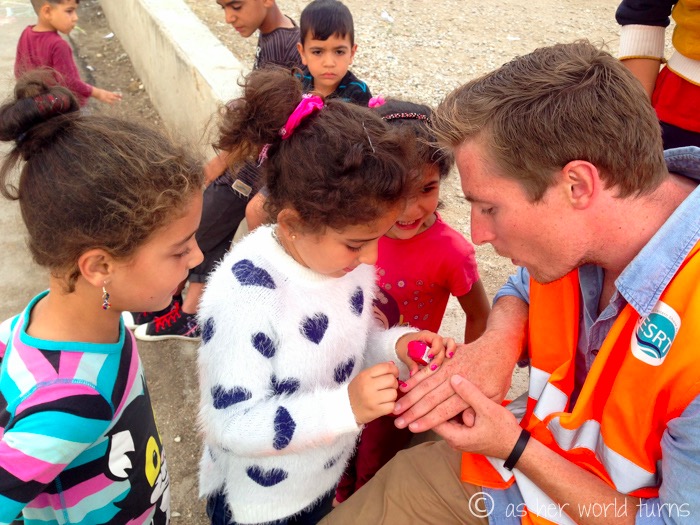
A few mornings per week members of our group volunteer with Zaporeak Kitchen, a group from the Basque region of Spain who provides lunch for all 1300 refugees in Souda camp. On this particular day we arrived at 8:30am to cube thawed chicken breasts for the first hour:

Then we took a break to clean up everything as the chefs cooked all the ingredients into a chicken curry stew. This break may have involved wine and tapas at 10:30am.

Next we set up two assembly lines and spent an hour scooping portions of food into the trays, and then sealing them shut in preparation for delivery at camp. (My job was to seal the corners of the lid — that’s how specific these assembly lines were!) And each line competed with each other to see who could reach their goal the fastest. Very fun atmosphere.

Here is a glimpse of their weekly lunch menu:

A few more photos from the morning — by the end, all of the meals were packed up into two vehicles to be delivered to the camp for distribution:

Our group did get to visit Vial one night — that’s the other refugee camp located inland. As stated above, we are not allowed inside, but they permitted us to project a movie for the kids and families one Friday evening in a sports field next to the camp. We started with a bunch of kids’ cartoons, and then showed the film Pele: Birth of a Legend about the rise of a soccer star from the slums of Brazil. Everything was translated in both Farsi and Arabic subtitles. The evening was a big hit and CESRT hopes to do more of these screenings until the weather gets too cold.

I want to talk about the camaraderie between the volunteers, as it was so lovely to meet people through CESRT.
My first night with the group, a couple of us made a veggie pasta dinner at Sun Rooms. This is Helene from Germany, Murielle from Switzerland, Chris from the U.K., and Jon-Mark from the U.K. (with the wonky smile and epic hair!).

Another afternoon, Gudrun (from Germany) invited Hannah (from Scotland) and myself over to her apartment for a lovely lunch on her balcony after we spent a morning sorting baby clothes in the Karfas warehouse.

I had the loveliest time getting to know Gudrun! She had a car she dubbed “the bus” and very kindly offered everyone rides. We got dinner by the port one evening and it was great to get to know her.

And this is Jasmin and Olivia from Denmark — they are both around age 21, and just the most competent, self-assured, and kind human beings. I loved getting to know them.

I developed a wonderful bond with Frank and Eileen from Ireland — they are so welcoming to everyone they meet. On one of our Sundays off, they brought me to the village of Pyrgi and then Mesta. We met up with volunteers Gustavo (from Mexico) and Gabrielle (from Spain) and had a delightful lunch together.

The town of Pyrgi is famous for its chiseled reliefs on all of the houses and buildings in town:

And then Frank and Eileen very kindly brought me to this beach in the south known for its black volcanic stones:

Here is the outside of Sun Rooms where I stayed:

And the inside of my room (yes, the fact that I could come back to this at night while refugees slept in tents haunted me, especially on nights when I heard the wind howling outside):

This is Toula, one of our dear, tirelessly committed leaders at CESRT — she is holding a kitten we rescued in Souda when the kids found it and started fighting over it. And on the right, you can see an example of one of the meals I cooked in my little kitchenette — I made most of my dinners here, sautéing veggies and serving them over pasta. I cooked lots of eggplant.

The view near Sun Rooms — some nights, before it got too cold, we’d go for a quick swim in the evening:

While most nights I cooked dinner in my room, we often would eat lunch while out and about — my go-to meal was a chicken pita for just over 2 euros (below left). The night I went out with Gudrun in the port, we got wine, sun-dried tomatoes with capers, and whipped garlic. Before leaving the island, I returned again for lightly battered eggplant.

Other meals out — babaganoush, tzatziki, Greek salad, pork gyro, more garlic sauce, pita, and baclava:

And since I find coffee everywhere I go, it will surprise no one that I fell in love with Coffee Island (a Greek chain) and their cappuccinos with cinnamon.

One last look at these iconic Greek stone windmills by the port:

I wish I could end on that note. But the situation is changing rapidly on Chios, and just last week a group of local right-wing fascists called Golden Dawn terrorized Souda camp two nights in a row, lighting several tents on fire and dropping boulders down on the tents. THIS IS VERY SERIOUS — one person died, and a pregnant woman miscarried her twins. Families are now sleeping outside in open spaces since they are too scared to return to the area where their tents were burned. Rather than seeking out the perpetrators, local police arrested some refugees in the camp as well as a few volunteers; the continued police presence is now seen as a threat.
Both the BBC and Huffington Post have reported on these crimes. It is vital that this gets more attention so that Europe (and beyond) will wake up and pay attention to this increasingly dire situation.
Here are photos from these reports. First, the boulders dropped onto tents from above:

And then the fire:

The aftermath:
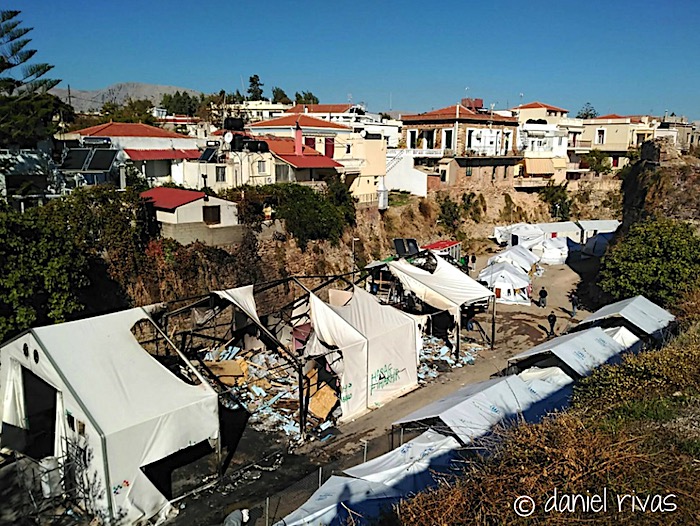



To make matters worse, more boats continue to land on Chios — seven last weekend alone — but the local municipality has intentionally delayed telling CESRT so that we have missed opportunities to greet new arrivals. This sort of resistance by local authorities feels like a slap in the face. They have also removed CESRT’s hut of supplies in the port(!). This is unconscionable.
Please take a moment to read this short blog post by Andy & Frances, the Scottish couple who head up CESRT. Their words about this past week cut to the heart of the matter.
A few days ago, people in Souda gathered together to take this photo from above camp: children spelling out the word “PEACE.” Feels like an appropriate final photo for this post, a glimmer of optimism following a violent and terrifying few days.

And that brings an end to this very long, photo-heavy post.
To my friends in Chios, currently living in Souda or Vial: stay strong. You deserve better, and one day you will get it, but the road is long. Keep the faith that better times are ahead.
To the rest of humanity: these refugees are our brothers and sisters. We need to do better to protect their rights. Urge countries to take in more refugees so the burden is not so heavy on Greece, and to speed up the process of moving these people towards proper housing, jobs, and eventually citizenship. They are in this situation by the lottery of their birth, and as fellow humans it is our duty to step up.
If you would like to make a donation to CESRT, you may do so here.


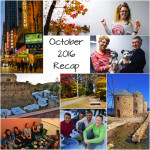




Many thanks for posting this – very illuminating.
From friends of Andy and Fran at The Highlands Support Refugees in Scotland
Thank you, Mike! We are so grateful for Andy & Frances’s leadership!
Thank you so much for sharing this and for all the heartfelt work that you are doing!
Thank you for the comment, Cinde! It was a life-changing experience and I am so glad I could share it here.
You are truly and angel helping these refugees! So are the many others helping these poor folks! May God bless you all for all the work you are doing!
Thank you Chuck! It was a privilege to spend time in Chios and get to know the refugees. Thanks for reading the post!
I just now found your post, as I am looking at the possibility of volunteering on Chios. Thank you so much for your story, the details, the photos, and for giving me a sense of the place before going.
I am so glad you are looking into volunteering there. I think about the people there often (refugees and volunteers) and continue to follow what’s going on there via Facebook. Good luck with your travels!
How can an Asian like me help? I am a teacher by profession.
Hi Alvin, there are a lot of organizations (big and small) that you could look into volunteering with, some of which may have specific needs for teachers. I have not done much research but know there are lots of organizations involved in the refugee crisis throughout Europe. If you’re interested in learning more about CESRT specifically, check out their Facebook group and consider reaching out to the admins on there — that’s the best way to be in touch with them directly and see what their needs are. I am sure they would be glad to have your help! Here is the link: https://www.facebook.com/chiosesrt/. Hope that helps!